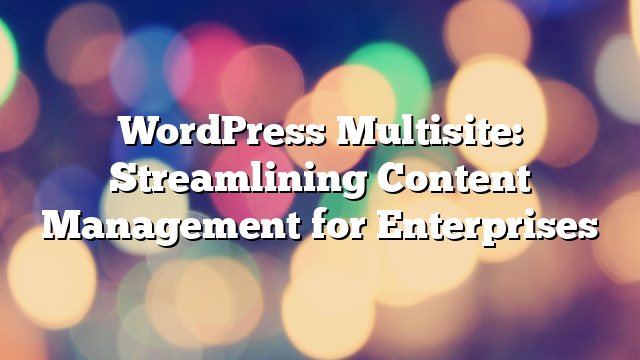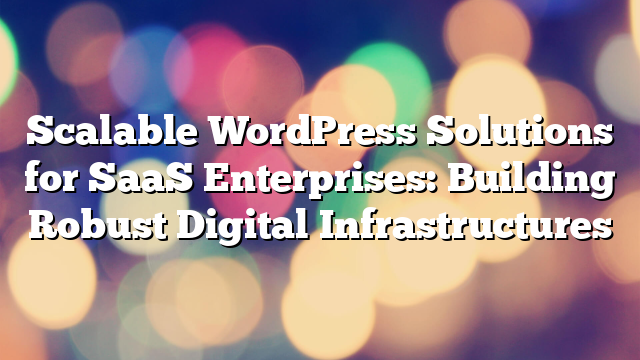WordPress Multisite: Streamlining Content Management for Enterprises
06.12.2024

Enterprises managing multiple websites often face challenges in maintaining consistency, updating content, and streamlining administrative tasks. WordPress Multisite, a powerful feature of the WordPress ecosystem, provides a solution by allowing businesses to manage multiple websites from a single dashboard. In this article, we explore how WordPress Multisite works, its benefits, use cases, and best practices for implementation.
What is WordPress Multisite?
WordPress Multisite is a feature that allows users to create a network of websites under a single WordPress installation. With this setup, enterprises can manage multiple websites efficiently, sharing themes, plugins, and even users across the network. Each site operates independently but is connected to the central network, simplifying management and reducing resource overhead.
Benefits of WordPress Multisite for Enterprises
1. Centralized Management
With WordPress Multisite, administrators can manage all websites from a single dashboard. This includes updates to themes, plugins, and core files, ensuring consistency and saving time.
2. Cost Efficiency
Since all websites share the same WordPress installation, hosting and maintenance costs are significantly reduced. Enterprises can allocate resources more effectively without compromising on functionality.
3. Scalability
Multisite is designed to handle networks of various sizes, from a few sites to thousands. This scalability makes it ideal for enterprises with growing digital footprints.
4. Shared Resources
The ability to share themes, plugins, and user roles across the network ensures consistency in branding and functionality. This also reduces the need for repetitive installations and configurations.
5. Simplified User Management
Administrators can assign user roles and permissions across the network, streamlining access control and ensuring security.
6. Enhanced Customization
While the network is centrally managed, each site can have its own unique settings, themes, and content, allowing for localized customization where needed.
Common Use Cases for WordPress Multisite
1. Enterprise-Level Organizations
Large companies often manage multiple regional or department-specific websites. WordPress Multisite enables them to maintain consistent branding while offering localized content and services.
2. Educational Institutions
Universities and schools can use Multisite to create dedicated websites for departments, courses, or campuses, all under one umbrella.
3. Media and Publishing Platforms
Media organizations can manage different publications or language versions of the same site using Multisite, simplifying content distribution and management.
4. Franchise Businesses
Franchises can create separate websites for each location while maintaining control over the network, ensuring a uniform brand experience across all sites.
5. Agencies and Developers
Web development agencies can use Multisite to manage client websites from a single installation, reducing overhead and improving efficiency.
Challenges of WordPress Multisite
1. Increased Complexity
Managing a network of websites requires careful planning and expertise. Configuration errors or improper user permissions can impact the entire network.
2. Shared Resources Risks
While shared resources are a benefit, they can also pose risks. A poorly coded plugin or theme can affect all sites in the network.
3. Limited Independence
Individual sites may have limited customization options compared to standalone installations, depending on how the network is configured.
4. Backup and Restore Complexity
Backing up and restoring a Multisite network can be more complicated than a single site. Enterprises must ensure they have a robust backup strategy in place.
Best Practices for Implementing WordPress Multisite
1. Plan Your Network
Define the purpose of each site in the network and plan the architecture accordingly. Determine whether you’ll use subdomains (e.g., site.example.com) or subdirectories (e.g., example.com/site) for your sites.
2. Use Multisite-Compatible Themes and Plugins
Ensure that your chosen themes and plugins are compatible with WordPress Multisite to avoid functionality issues.
3. Implement Role-Based Access Control
Assign roles and permissions carefully to prevent unauthorized changes across the network. Use tools to monitor and manage user activities.
4. Optimize Performance
Use scalable hosting solutions, content delivery networks (CDNs), and caching plugins to ensure your network performs well even under high traffic.
5. Regular Maintenance and Updates
Keep the WordPress core, themes, and plugins updated to ensure security and compatibility. Regularly monitor for potential conflicts or issues.
6. Test Before Deployment
Thoroughly test your Multisite network in a staging environment before launching to identify and resolve any issues.
Conclusion
WordPress Multisite offers enterprises a powerful solution for managing multiple websites efficiently and cost-effectively. With centralized management, shared resources, and scalable architecture, it empowers businesses to streamline operations while maintaining flexibility and customization. By following best practices and addressing potential challenges, enterprises can harness the full potential of Multisite to achieve their digital goals.
Interested in implementing WordPress Multisite for your organization? Contact AllWebDev today and let us help you build a network that meets your unique needs.



